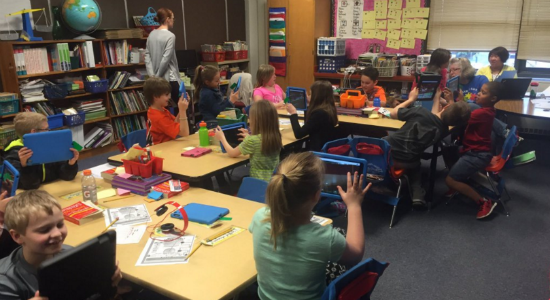
Nearpod VR: Real-world experiences without leaving the classroom
Checking for understanding using real data in AP Chem. Love @nearpod for quick formative assessment!! pic.twitter.com/VKHvODHItb
— Beth McDonald (@BethMcDscience) April 11, 2016
@Sam7961167 Need more @nearpod …you can never have enough ??
— Mr.Pachan (Mr.P) (@BrandonPachan) April 11, 2016
In January of this year, we launched Nearpod VR as a way for teachers to bring real-world experiences from across the globe (and the solar system) into their classrooms to inspire and engage students. Adding new features to a platform that’s already being used – and loved! – by millions of teachers and students is always a risky move.
But we knew we were “getting it right” when teachers jumped on board and quickly incorporated VR activities in their lesson plans to support engaging, student-centered instruction. While this was no surprise, it was encouraging to see that teachers understood our approach and embraced VR in such a positive way.
“Rather than the VR being the sole component of this amazing educational tool, it is used to enhance engaging, interactive lessons. The VR experiences made my young students feel as if they were immersed in each location, resulting in a much firmer grasp of concepts and ideas. This is an enormously powerful tool that allows students to dig deep into concepts, root around, and pull out the knowledge they might have missed without this extraordinary experience. The power to engage students resulting in excitement about learning is a rare gem in the educational field,” explains elementary school teacher Kate Chirhart (you can read Kate’s blog about Nearpod VR in full here).
@SharpsburgES #bragupwarriors Blown away students inspiring career research/planning @nearpod w/vr trip 2 Stanford pic.twitter.com/lRDvcG4Uuo
— James Funkhouser (@2coolcounselor) April 1, 2016
Convinced of the potential that VR technologies have in the classroom, our product team ensured that we were hitting three core principles while developing this new offering:
1. Virtual Reality should be used to increase student engagement.
2. VR must be incorporated as part of a well-designed, pedagogically sound lesson. More specifically, VR activities should be used to build empathy and real-world exposure by immersing students in new experiences.
3. Like all other Nearpod features, VR should be accessible from almost any device.
Both our VR features and VR-enabled lesson plans have received a lot of positive coverage [1][2][3] and tons of awesome feedback from teachers [4]. But as with any new technology, there are several misconceptions about VR that we’ve heard from teachers, admins, and parents, and we seek to address and clarify these below:
- “VR viewers isolate kids. Don’t we want to promote collaboration and discussion?”
When used appropriately, Nearpod VR experiences should not take more than 5-10 minutes of class. We recommend that students participate in VR activities as part of a lesson, not a replacement for instruction, the teacher, or the classroom experience. We see VR as another engagement and learning tool for teachers to add to their toolkit.
- “Kids don’t need more screen time. VR will make them feel dizzy.”
Incorporating VR in the classroom does not mean strapping a headset to your students for an entire class period. As mentioned above, Nearpod VR experiences last 5-10 minutes. Additionally, if you’re worried that the headset may make students feel ill, fear not! Our VR activities work with or without headsets.
- “VR is only accessible to affluent schools, this type of technology will be too costly to integrate into most schools.”
While new technologies are typically associated with high costs, Nearpod VR only requires an internet connection and a device. That’s it. Our headsets, which come for free when a school buys a Nearpod premium edition, are a great way to enhance a VR experience, but are not necessary to experience Nearpod VR. We’re confident that our multi-platform approach, the growing percentage of students in the US who own smartphones [5], increasingly high quality internet connection available in US public school districts [6], and our ready-to-teach library of VR lessons make Nearpod VR accessible to schools and districts regardless of zip code. We do recognize that not all schools have devices, connectivity, or a student population with internet access at home, so as part of ongoing efforts to increase access, we launched a grant program (January 15 – March 31, 2016) where we provide devices, Nearpod School edition, headsets, and VR content to qualifying schools.
- “There’s no research behind VR improving learning outcomes.”
Although there’s little formal research about incorporating the newest advances in VR technology in K-12 classrooms, it’s clear from early teacher feedback [7] [8] that students are engaged and excited to learn during a Nearpod VR lesson. In addition, there is a well established body of research in education that links student engagement to positive academic, social, and emotional outcomes [9][10], and a growing body of research that reports positive impacts of virtual reality [11][12] . We believe that by adding a VR component to Nearpod, we’re equipping teachers with tools to further engage their students.
Don’t take our word for it, try VR in your classroom!
Download a VR lesson from our content store or build your own VR activity as part of your next lesson (learn how here).
After you try it out, please share your feedback with us on Twitter @nearpod using #NearpodVR!


